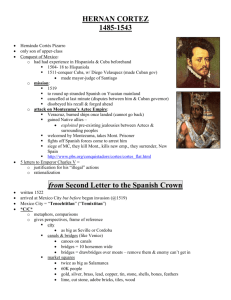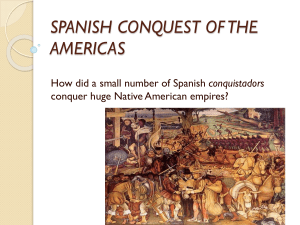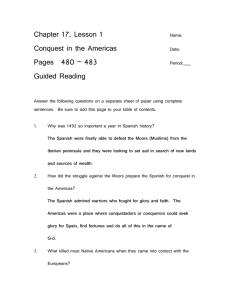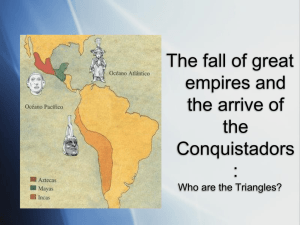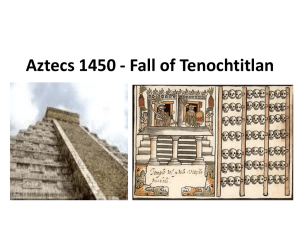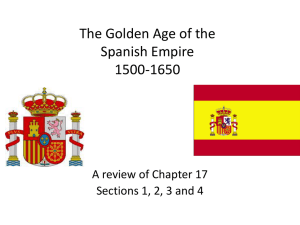Cortes and the Aztecs
advertisement
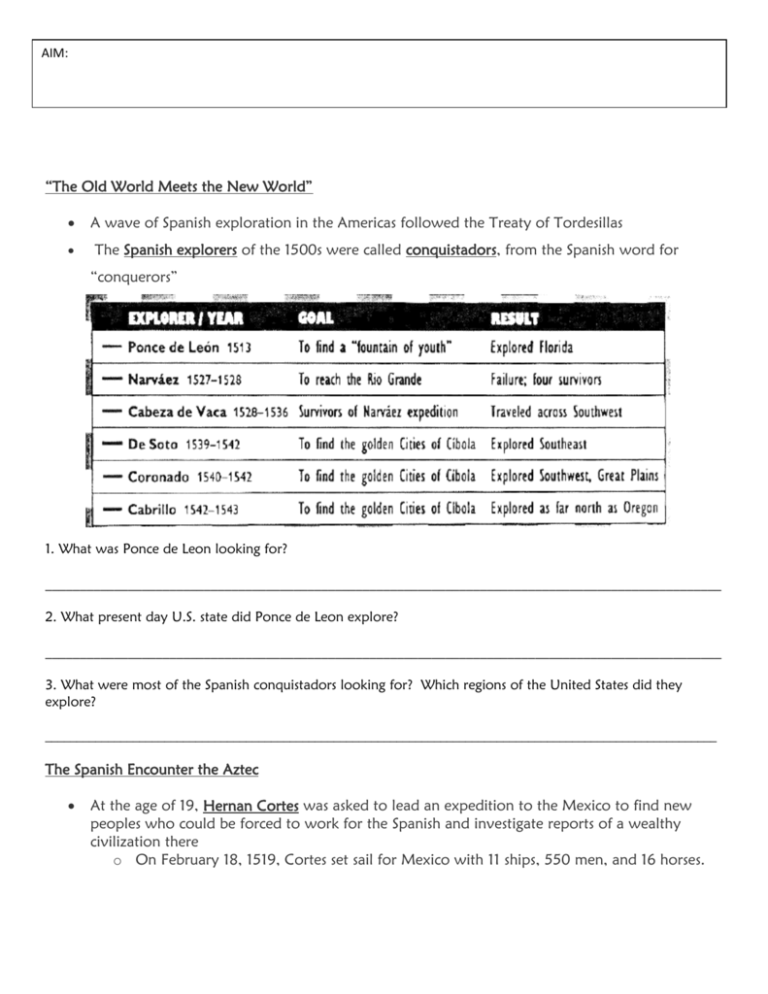
AIM: “The Old World Meets the New World” A wave of Spanish exploration in the Americas followed the Treaty of Tordesillas The Spanish explorers of the 1500s were called conquistadors, from the Spanish word for “conquerors” 1. What was Ponce de Leon looking for? __________________________________________________________________________________________________ 2. What present day U.S. state did Ponce de Leon explore? __________________________________________________________________________________________________ 3. What were most of the Spanish conquistadors looking for? Which regions of the United States did they explore? ___________________________________________________________________________________________________________ The Spanish Encounter the Aztec At the age of 19, Hernan Cortes was asked to lead an expedition to the Mexico to find new peoples who could be forced to work for the Spanish and investigate reports of a wealthy civilization there o On February 18, 1519, Cortes set sail for Mexico with 11 ships, 550 men, and 16 horses. The following is an Aztec account of the arrival of the Spanish: "When I went to the shores of the great sea, there was a mountain range or small mountain floating in the midst of the water, moving here and there without touching the shore. It is true that strange people have come to the shores of the great sea. They were fishing from a small boat. They fished until late and then went back to their two great towers and climbed up into them. There were about fifteen of these people, some with blue jackets, others with red, some with black or green. They have very light skin, much lighter than ours. They all have beards, and their hair is fair and comes only to their ears." What do you think the “floating mountain” actually was? __________________________________________________________________________________________ How did the Aztec’s describe the Spanish conquistadors? __________________________________________________________________________________________ In the spring of 1519, a courier arrived in Tenochtitlan, capital of the Aztec empire. He had news for the emperor, Montezuma II. Bearded white men bearing crosses were encamped on the eastern shores of the emperor’s realm. Montezuma was worried. For several years he had heard reports of strange men with “very light skin” operating in the Caribbean. Now these strange men had come to his lands, and Montezuma did not know what to do. Cuitlahuac (Montezuma’s brother): "I pray to our gods that you will not let the strangers into your house. They will cast you out of it and overthrow your rule. When you try to recover what you have lost, it will be too late." Cacama (Montezuma’s nephew): "If their demands don’t please Montezuma, he can punish them by sending his hosts of brave warriors against them." What are the arguments both for and against allowing the Spaniards to enter Tenochtitlan? Which piece of advice do you think Montezuma listens to? __________________________________________________________________________________________ __________________________________________________________________________________________ __________________________________________________________________________________________ As Cortes headed inland toward the Aztec capital of Tenochtitlan, he was helped by Malinche, a young Native American woman who served as his translator and adviser o Malinche knew both the Mayan and Aztec languages, and was later baptized into the Catholic religion, receiving the new name Dona Marina Cortes’s first impression of Montezuma: Every object found in Montezuma’s palace is made with gold, silver, precious stones, and feathers; the gold and silver being shaped so perfectly that it cannot be outdone by any metal worker in the world; the stone work executed with such perfection that it is difficult to imagine what instruments could have been used; and the feather work superior to the finest productions in wax or embroidery. The extent of Montezuma's empire has not been determined, since to whatever point he sends his messengers, even seven-hundred miles from his capital, his commands were obeyed, although some of his provinces were in the midst of countries with which he was at war. How would you describe Cortes’s view of Montezuma? __________________________________________________________________________________________ __________________________________________________________________________________________ __________________________________________________________________________________________ Malinche helped Cortes form alliances with the native Tlaxcala people who were at constant war against Montezuma and his forces When Montezuma learned that Cortes was negotiating with the Tlaxcalan, he promised Cortes that he would pay a yearly tribute to the king of Spain if Cortes did not attack the Aztecs However, after hearing a rumor that Montezuma was going to ambush Cortes, the Spanish attacked first, killing over 6,000 Aztecs As Cortes marched into the city of Tenochtitlan on November 8, 1519 he was amazed by its beauty Surrounded by thousands of Aztecs, Cortes decided to take Montezuma hostage. Montezuma did not resist and under instructions from Cortes, he stopped all human sacrifice and ordered the statues of the gods to be replaced with Christian crosses and images of the Virgin Mary Aztec Account of Montezuma’s Death And when they had arrived and entered the great palace, they seized Montezuma and placed him under guard, keeping him constantly under surveillance. As for the other [nobles], they were allowed to leave. And when this happened, a cannon was shot and Montezuma was killed. All was in disorder. One ran without direction; people were scattered without rhyme or reason; they just ran off, as if they were being chased. It was as if they had seen something awful. They were completely overcome with terror, as if everybody had lost heart. Even before it grew dark, the panic spread through the city; fear dominated all of them, so they could only sleep with dread. What happened after Montezuma’s death? __________________________________________________________________________________________________ __________________________________________________________________________________________________ Aztec priests organized a rebellion and drove the Spanish out of Tenochtitlan o Cortes fled to the land of the Tlaxcalan people and prepared for another battle “They came in battle formation, as conquerors…their iron weapons sparkled in the sun, and their [flags] fluttered like bats. Their deer are as tall as the roof of a house and carry them wherever they wish to go. Their cannons roared and caused us to faint and grow deaf. A thing like a ball of stone comes out shooting sparks and raining fire. It can cause a tree to shatter into splinters as if it has exploded from within. They terrified everyone who saw them.” Based on the picture above, how did Cortes attack the city of Tenochtitlan? Why do you think he chose this method of attack? __________________________________________________________________________________________ __________________________________________________________________________________________ __________________________________________________________________________________________ What advantages did the Spanish have over the Aztecs? __________________________________________________________________________________________ __________________________________________________________________________________________ __________________________________________________________________________________________ While the Spaniards were in Tlaxcala, a great plague broke out here in Tenochtitlan…Sores erupted on our faces, our breasts, our bellies; we were covered with agonizing sores from head to foot. The illness was so dreadful that no one could walk or move…If they did move their bodies, they screamed with pain.” At this time New Spain was extremely full of people, and when the smallpox began to attack the Indians it became so great a pestilence [disease] among them throughout the land that in most provinces more than half the population died; in others the proportion was little less. For as the Indians did not know the remedy for the disease and were very much in the habit of bathing frequently, whether well or ill, and continued to do so even when suffering from smallpox, they died in heaps, like bedbugs. Many others died of starvation, because, as they were all taken sick at once, they could not care for each other, nor was there anyone to give them bread or anything else. In many places it happened that everyone in a house died, and, as it was impossible to bury the great number of dead, they pulled down the houses over them in order to check the stench that rose from the dead bodies so that their homes became their tombs. This disease was called by the Indians ‘the great leprosy’ because the victims were so covered with pustules [pimples] that they looked like lepers. Even today one can see obvious evidences of it in some individuals who escaped death, for they were left covered with pockmarks. How did smallpox affect the Native American’s bodies? What were the effects of the disease on society? _________________________________________ __________________________________________________________________________________________ __________________________________________________________________________________________ “Their trappings and arms are all made of iron. They dress in iron and wear iron casques on their heads. Their swords are of iron, their bows are of iron, their shields are of iron, their spears are iron: their deer carry them on their backs wherever they wish to go. These deer, our Lord, are as tall as the roof of a house.” “They came in battle array, as conquerors…their spears glinted in the sun, and their [flags] fluttered like bats. They made a loud clamor as they marched, for their coats of mail and their weapons clashed and rattled…They terrified everyone who saw them.” "The cannon roared. It caused us to faint and grow deaf. A thing like a ball of stone comes out of its entrails: it comes out shooting sparks and raining fire. If it is aimed against a mountain, the mountain splits and cracks open. It can At this time, when everyone was enjoying the fiesta, when everyone was already dancing, when everyone was already singing…the Spaniards determined to kill people. They came into the patio, armed for battle. At that moment, they then attacked all the people, stabbing them, spearing them, wounding them with their swords. They struck some from behind, who fell instantly to the ground with their entrails hanging out [of their bodies]. They cut off the heads of some and smashed the heads of others into little pieces. Some tried to escape, but the Spaniards murdered them at the gates while they laughed. Others climbed the walls, but they could not save themselves. Others entered the communal house, where they were safe for a while. Others lay down among the victims and pretended to be dead. But if they stood up again they [the Spaniards] would see them and kill them. “When the Spaniards were installed in the palace, they asked Moctezuma about the city’s resources and reserves…They questioned him closely and then demanded gold. Moctezuma guided them to it…And when they arrived, when they entered the house of treasures, it was like they had arrived in Paradise. They searched everywhere and coveted everything, for, yes, they were dominated by their greed. Then they took out all of the goods which were his [Moctezuma's] own exclusive possessions: his personal belongings, all of which were precious: necklaces with thick stones, arm bands of quetzal feathers, bracelets of gold, golden bands with shells for the knees, ankle bracelets with little gold bells, and the royal crowns and all the royal attire, without number, everything that belonged to him and was reserved to him only. They took everything, they appropriated everything, all they snatched as if it were their own. They appropriated everything as if it was their luck [to find it]. And after they removed the gold, when they had torn it all off, they piled it up all the precious feathers, everything else in the middle of the courtyard, in the center of it. The Spaniards grinned like little beasts and patted each other with delight. "[The Aztecs] have defeated us and killed us and carried off many of our vassals for sacrifice. All the provinces which had been raided by Moctezuma and placed under his rule were ill disposed towards the [Aztecs], and that as their inhabitants were carried off by force to the wars, they did not fight with good will. The place from which the most continuous trouble came to them was a very great city a day's march away in the south, called Cholula, whose inhabitants are most treacherous. Moctezuma kept garrisons of many warriors stationed in all the provinces in addition to the great force he could bring from the city, and that all the provinces paid tribute of gold and silver, feathers, stones, cloth and cotton, and Indian men and women for sacrifice and others for servants, that he [Moctezuma] was such a great prince that he possessed everything he could desire, that the houses where he dwelt were full of riches and [precious] stones which he had robbed Everyday, before they undertake any work, they burn incense in the said mosques [temples] and sometimes they sacrifice their own persons, some hacking the body with knives; and they offer up to their idols all the blood which flows, sprinkling it on all sides of those mosques, at other times throwing it up towards the heavens, and practicing many other kinds of ceremonies, so that they undertake nothing without first offering sacrifice there. They have another custom, horrible, and abominable, and deserving punishment, and which we have never before seen in any other place, and it is this, that, as often as they have anything to ask of their idols, in order that their petition may be more acceptable, they take many boys or girls, and even grown men and women, and in the presence of those idols they open their breasts, while they are alive, and take out the hearts and entrails, and burn the said entrails and hearts before the idols, offering that smoke in sacrifice to them. Your Majesties may rest assured that, according to the size of the land, which to us seems very considerable, and the many mosques which they have, there is no year, as far as we have until now discovered and seen, when they do not kill and sacrifice in this manner some three or four thousand souls. Now let Your Royal Highnesses consider if they ought not to prevent so great an evil and crime, and certainly God, OurAZTEC Lord, will beLEGAL well pleased,TEAM if, through the command of Your Royal Highnesses, these peoples should be initiated and instructed in our Very Holy Catholic Faith . . . . Based on the documents provided, list all of the weapons and technological advances that the Spanish possessed. Which side do you think has an advantage from a military standpoint? Do you think it’s an unfair advantage? Were the Spanish brutal and harsh in their treatment of the Aztecs? Use specific evidence from the documents to support your answer. What was the main reason that the Spaniards traveled to the Yucatan Peninsula? Do you think they were willing to achieve their goals by any means necessary? Were the Spanish justified in their conquering of the Aztec peoples? CONQUISTADOR LEGAL TEAM Based on the drawing, who is the aggressor and who is the victim, the Spanish or the Aztecs? What is the significance of the burning of the Virgin Mary and the cross? How did the Spanish know that the Aztecs were going to attack them? What was the Aztecs strategy? How did the Aztecs treat their neighbors? How do you think the Spanish felt about this? What were some of the gruesome religious customs that the Aztecs had? Did the Spanish conquistadors have a right to attack the Aztecs? Why?

